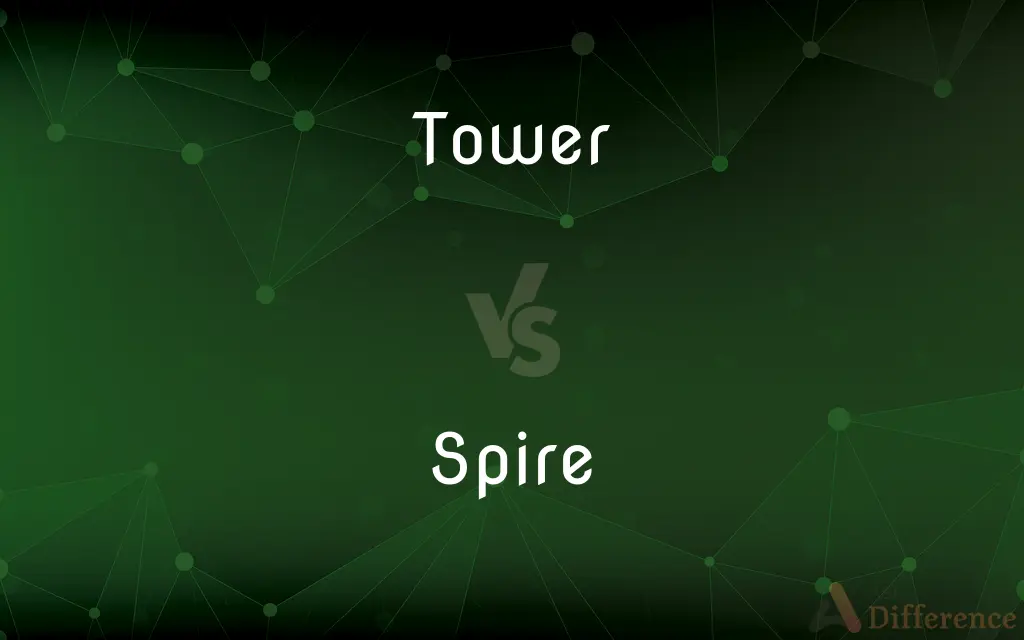Tower vs. Spire — What's the Difference?
Edited by Tayyaba Rehman — By Maham Liaqat — Updated on March 27, 2024
A tower is a tall, often standalone structure used for various purposes, including observation or as part of a building, while a spire is a tapering conical or pyramidal structure on top of a building, especially a church.

Difference Between Tower and Spire
Table of Contents
ADVERTISEMENT
Key Differences
Towers serve multiple functions, ranging from architectural focal points to practical uses such as telecommunications, defense, and observation. They are characterized by their significant height and can be either independent structures or integrated parts of larger buildings. Towers often have a broader base and may include features such as parapets, observation decks, and sometimes spires at their tops. On the other hand, spires are primarily architectural elements that taper to a point and are usually found atop buildings, particularly churches or cathedrals, serving as symbolic reaches towards the heavens. Spires are designed to accentuate the verticality of a structure, contributing to the building's overall aesthetic and skyline silhouette.
While towers are notable for their structural prominence and utility, offering panoramic views and housing various functions within their often spacious interiors, spires are more symbolic, with their primary purpose being to enhance the building’s architectural harmony and spiritual symbolism. Spires, with their slender, pointed design, are not typically meant for human occupancy or practical use beyond their architectural and symbolic significance.
The construction of towers is a feat of engineering that requires consideration of materials, wind resistance, and foundation depth, making them complex structures capable of standing alone or as part of larger buildings. In contrast, spires, though also engineering marvels, especially in historical contexts, are constructed as components of a building's roof, emphasizing vertical lines and adding to the aesthetic appeal and grace of the structure.
In terms of historical and cultural significance, towers have been built for millennia for a variety of purposes, including military defense, religious observances, and as status symbols for cities and institutions. Spires, however, have a more specific association with Christian church architecture, where they have been used to point towards the sky, symbolizing a connection between the earthly and divine.
Both towers and spires play crucial roles in the landscapes of cities and towns around the world. Towers, due to their standalone nature and multifunctional uses, often become landmarks or points of reference. Spires, while also contributing to the skyline, serve more as indicators of cultural and religious identity, marking the locations of places of worship and contributing to the historical and spiritual character of their surroundings.
ADVERTISEMENT
Comparison Chart
Definition
A tall structure, either freestanding or part of a building, used for various purposes.
A tapering structure on top of a building, often conical or pyramidal, primarily seen in church architecture.
Purpose
Observation, defense, telecommunications, architectural.
Architectural enhancement, spiritual symbolism.
Occupancy
Often designed for human use, with interior spaces.
Not designed for occupancy; serves as a decorative or symbolic element.
Construction
Requires significant engineering, can be standalone or integrated.
Part of a building's roof structure, emphasizing verticality.
Cultural Significance
Varied, including military, religious, and civic.
Primarily associated with Christian church architecture.
Design
Can have a broad base, possibly tapering towards the top, may include features like observation decks.
Slender and pointed, designed to accentuate the verticality of a building.
Compare with Definitions
Tower
A tall structure for observation or defense.
The watchtower provided a panoramic view of the surrounding area.
Spire
A tapering architectural element atop a church.
The church's spire could be seen for miles around.
Tower
An architectural element of a building.
The office tower dominates the city's skyline.
Spire
A symbol reaching towards the heavens.
The cathedral's spire points skyward. embodying spiritual aspiration.
Tower
A modern telecommunications structure.
The cell tower ensures coverage across the region.
Spire
Part of Gothic church architecture.
Gothic cathedrals are renowned for their soaring spires.
Tower
A component of castle architecture for protection.
The castle's central tower was a place of refuge during sieges.
Spire
A decorative feature enhancing a building’s verticality.
The building's spire adds elegance to its design.
Tower
A historical landmark or monument.
The leaning tower of Pisa is known worldwide.
Spire
An element contributing to a city's skyline.
The city's skyline is punctuated by church spires.
Tower
A tower is a tall structure, taller than it is wide, often by a significant factor. Towers are distinguished from masts by their lack of guy-wires and are therefore, along with tall buildings, self-supporting structures.
Spire
A spire is a tall, slender, pointed structure on top of a roof or tower, especially at the summit of church steeples. A spire may have a square, circular, or polygonal plan, with a roughly conical or pyramidal shape.
Tower
A tall, narrow building, either free-standing or forming part of a building such as a church or castle
The south-west tower is a wonderful example of late Gothic
Spire
A top part or structure that tapers upward, such as a rock formation or steeple.
Tower
A tall structure that houses machinery, operators, etc.
A control tower
Spire
A slender, tapering plant part.
Tower
Rise to or reach a great height
He seemed to tower over everyone else
Spire
A spiral.
Tower
(of a bird) soar to a great height, especially (of a falcon) so as to be able to swoop down on the quarry.
Spire
A single turn of a spiral; a whorl.
Tower
A building or part of a building that is exceptionally high in proportion to its width and length.
Spire
The area farthest from the aperture and nearest the apex on a coiled gastropod shell.
Tower
A tall, slender structure used for observation, signaling, or pumping.
Spire
To furnish with a spire.
Tower
One that conspicuously embodies strength, firmness, or another virtue.
Spire
To rise and taper steeply.
Tower
(Computers) A computer system whose components are arranged in a vertical stack and housed in a tall, narrow cabinet.
Spire
The stalk or stem of a plant.
Tower
To appear at or rise to a conspicuous height; loom
"There he stood, grown suddenly tall, towering above them" (J.R.R. Tolkien).
Spire
A young shoot of a plant; a spear.
Tower
To fly directly upward before swooping or falling. Used of certain birds.
Spire
Any of various tall grasses, rushes, or sedges, such as the marram, the reed canary-grass, etc.
Tower
To demonstrate great superiority; be preeminent
Towers over other poets of the day.
Spire
A sharp or tapering point.
Tower
A very tall iron-framed structure, usually painted red and white, on which microwave, radio, satellite, or other communication antennas are installed; mast.
Spire
(architectural element) A tapering structure built on a roof or tower, especially as one of the central architectural features of a church or cathedral roof.
The spire of the church rose high above the town.
Tower
A similarly framed structure with a platform or enclosed area on top, used as a lookout for spotting fires, plane crashes, fugitives, etc.
Spire
The top, or uppermost point, of anything; the summit.
Tower
A water tower.
Spire
(mining) A tube or fuse for communicating fire to the charge in blasting.
Tower
A control tower.
Spire
One of the sinuous foldings of a serpent or other reptile; a coil.
Tower
Any very tall building or structure; skyscraper.
The Sears Tower
Spire
A spiral.
Tower
(figuratively) An item of various kinds, such as a computer case, that is higher than it is wide.
Spire
(geometry) The part of a spiral generated in one revolution of the straight line about the pole.
Tower
(informal) An interlocking tower.
Spire
(of a seed, plant etc.) to sprout, to send forth the early shoots of growth; to germinate.
Tower
(figurative) A strong refuge; a defence.
Spire
To grow upwards rather than develop horizontally.
Tower
(historical) A tall fashionable headdress worn in the time of King William III and Queen Anne.
Spire
(transitive) To furnish with a spire.
Tower
(obsolete) High flight; elevation.
Spire
To breathe.
Tower
The sixteenth trump or Major Arcana card in many Tarot decks, usually deemed an ill omen.
Spire
To breathe.
Tower
(cartomancy) The nineteenth Lenormand card, representing structure, bureaucracy, stability and loneliness.
Spire
To shoot forth, or up in, or as if in, a spire.
It is not so apt to spire up as the other sorts, being more inclined to branch into arms.
Tower
One who tows.
Spire
A slender stalk or blade in vegetation; as, a spire grass or of wheat.
An oak cometh up a little spire.
Tower
(intransitive) To be very tall.
The office block towered into the sky.
Spire
A tapering body that shoots up or out to a point in a conical or pyramidal form. Specifically (Arch.), the roof of a tower when of a pyramidal form and high in proportion to its width; also, the pyramidal or aspiring termination of a tower which can not be said to have a roof, such as that of Strasburg cathedral; the tapering part of a steeple, or the steeple itself.
A spire of land that stand apart,Cleft from the main.
Tall spire from which the sound of cheerful bellsJust undulates upon the listening ear.
Tower
(intransitive) To be high or lofty; to soar.
Spire
A tube or fuse for communicating fire to the chargen in blasting.
Tower
To soar into.
Spire
The top, or uppermost point, of anything; the summit.
The spire and top of praises.
Tower
A mass of building standing alone and insulated, usually higher than its diameter, but when of great size not always of that proportion.
Spire
A spiral; a curl; a whorl; a twist.
Tower
A citadel; a fortress; hence, a defense.
Thou hast been a shelter for me, and a strong tower from the enemy.
Spire
A tall tower that forms the superstructure of a building (usually a church or temple) and that tapers to a point at the top
Tower
A headdress of a high or towerlike form, fashionable about the end of the seventeenth century and until 1715; also, any high headdress.
Lay trains of amorous intriguesIn towers, and curls, and periwigs.
Tower
High flight; elevation.
Tower
To rise and overtop other objects; to be lofty or very high; hence, to soar.
On the other side an high rock towered still.
My lord protector's hawks do tower so well.
Tower
To soar into.
Tower
A structure taller than its diameter; can stand alone or be attached to a larger building
Tower
Anything tall and thin approximating the shape of a column or tower;
The test tube held a column of white powder
A tower of dust rose above the horizon
A thin pillar of smoke betrayed their campsite
Tower
A powerful small boat designed to pull or push larger ships
Tower
Appear very large or occupy a commanding position;
The huge sculpture predominates over the fountain
Large shadows loomed on the canyon wall
Common Curiosities
What is the primary function of a tower?
Towers serve various functions including defense, observation, communication, and as architectural features.
How do towers contribute to urban landscapes?
Towers can serve as landmarks, offer panoramic views, and house various functions, significantly contributing to the functionality and aesthetics of urban landscapes.
Are spires found on buildings other than churches?
Primarily, spires are associated with church buildings, but they can also be found on other structures as decorative elements emphasizing verticality.
What distinguishes a tower from a spire in architecture?
A tower is a tall, often standalone structure with practical uses or as part of a larger building, while a spire is a slender, tapering architectural element on top of a building, primarily for symbolic and decorative purposes.
What role do spires play in church architecture?
In church architecture, spires contribute to the building's aesthetic and spiritual symbolism, emphasizing verticality and the connection between the earthly and the divine.
How are spires constructed?
Spires are engineered to be lightweight and are constructed as part of a building’s roof, often requiring intricate craftsmanship, especially in historical buildings.
Can a spire be considered a type of tower?
While a spire shares some characteristics with towers, such as vertical emphasis, it is specifically a tapering structure atop a building, not a standalone structure or one designed for practical use.
What is the symbolic meaning of a spire?
Spires symbolize reaching towards the heavens, embodying spiritual aspirations and enhancing a building's connection to the divine.
Do towers always have a functional purpose?
While many towers are built for specific functions, some are primarily decorative or serve as architectural statements within their landscapes.
Can towers have spires?
Yes, some towers may have spires on top as part of their design, combining the practical aspects of a tower with the symbolic, aesthetic features of a spire.
Share Your Discovery

Previous Comparison
Gram vs. Graph
Next Comparison
Critical vs. ImportantAuthor Spotlight
Written by
Maham LiaqatEdited by
Tayyaba RehmanTayyaba Rehman is a distinguished writer, currently serving as a primary contributor to askdifference.com. As a researcher in semantics and etymology, Tayyaba's passion for the complexity of languages and their distinctions has found a perfect home on the platform. Tayyaba delves into the intricacies of language, distinguishing between commonly confused words and phrases, thereby providing clarity for readers worldwide.














































